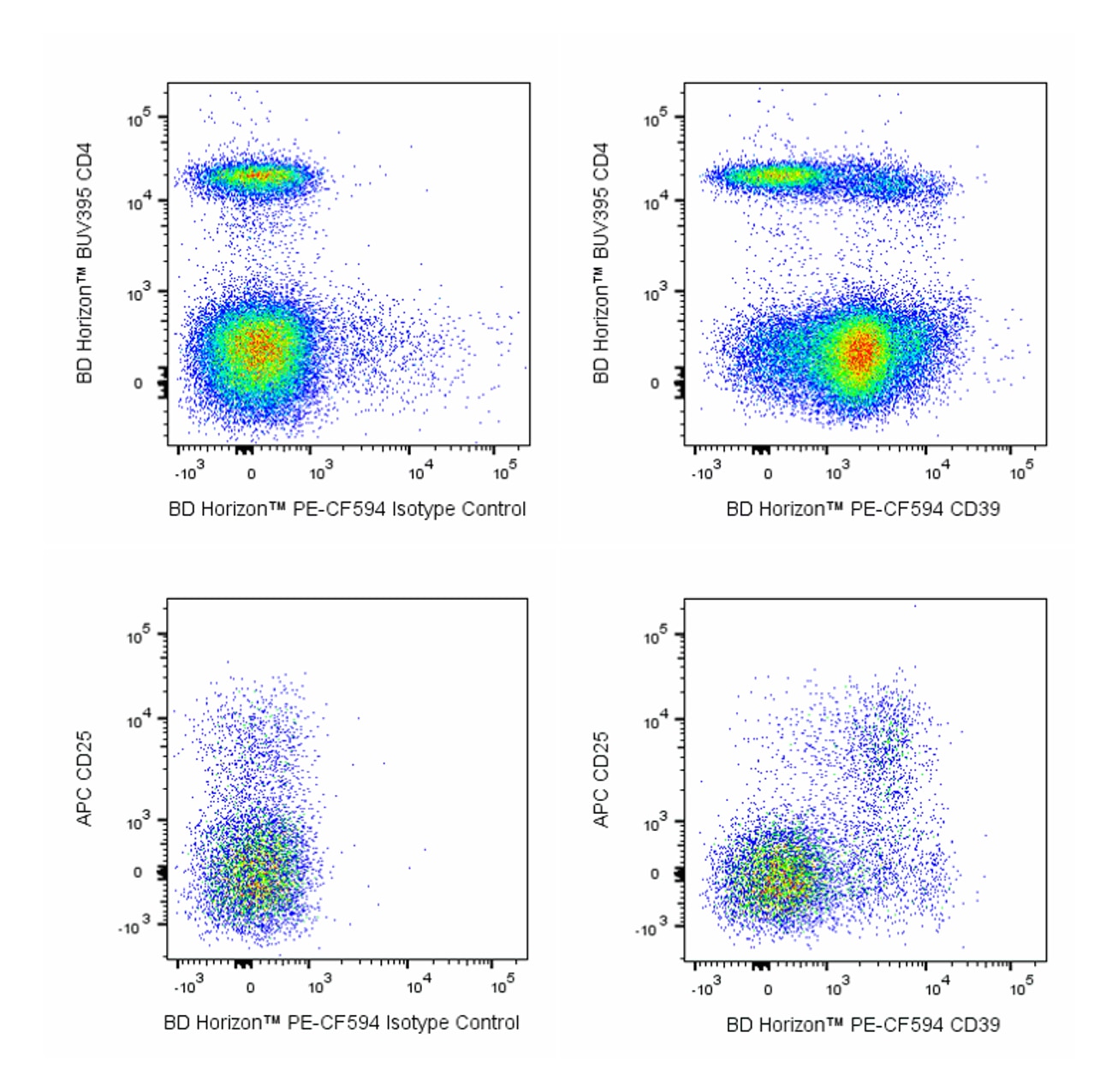Old Browser
Looks like you're visiting us from {countryName}.
Would you like to stay on the current country site or be switched to your country?


.png)

Multicolor flow cytometric analysis of CD39 expression on Mouse splenic lymphocytes. Balb/c mouse splenocytes were stained with BD Horizon™ BUV395 Rat Anti-Mouse CD4 (Cat. No. 563790/565974), APC Rat Anti-Mouse CD25 (Cat. No. 557192/561048), and either BD Horizon™ PE-CF594 Rat IgG2b, κ Isotype Control (Cat. No. 562308; Left Plots) or BD Horizon™ PE-CF594 Rat Anti-Mouse CD39 antibody (Cat. No. 567268; Right Plots) at 0.5 μg/test. 7-AAD (7-Amino-Actinomycin D) Solution (Cat. No. 559925) was added to cells right before analysis. Flow cytometry and data analysis were performed using a BD X-20 LSRFortessa™ Cell Analyzer System and FlowJo™ software. Data shown on this Technical Data Sheet are not lot specific. Upper panels: Bivariate pseudocolor density plots showing correlated expression of CD39 or Ig Isotype control versus CD4 staining were derived from gated events with the forward and side light-scatter characteristics of viable (7-AAD-negative) lymphocytes. Lower panels: Bivariate pseudocolor density plots showing correlated expression of CD39 or Ig Isotype control versus CD25 staining were derived from CD4-positive viable lymphocytes.
.png)

BD Horizon™ PE-CF594 Rat Anti-Mouse CD39
.png)
监管状态图例
未经BD明确书面授权,严禁使用未经许可的任何商品。
准备和存储
推荐的实验流程
BD® CompBeads can be used as surrogates to assess fluorescence spillover (compensation). When fluorochrome conjugated antibodies are bound to BD® CompBeads, they have spectral properties very similar to cells. However, for some fluorochromes there can be small differences in spectral emissions compared to cells, resulting in spillover values that differ when compared to biological controls. It is strongly recommended that when using a reagent for the first time, users compare the spillover on cells and BD® CompBeads to ensure that BD® CompBeads are appropriate for your specific cellular application.
商品通知
- Please refer to www.bdbiosciences.com/us/s/resources for technical protocols.
- Please observe the following precautions: Absorption of visible light can significantly alter the energy transfer occurring in any tandem fluorochrome conjugate; therefore, we recommend that special precautions be taken (such as wrapping vials, tubes, or racks in aluminum foil) to prevent exposure of conjugated reagents, including cells stained with those reagents, to room illumination.
- Source of all serum proteins is from USDA inspected abattoirs located in the United States.
- Caution: Sodium azide yields highly toxic hydrazoic acid under acidic conditions. Dilute azide compounds in running water before discarding to avoid accumulation of potentially explosive deposits in plumbing.
- Since applications vary, each investigator should titrate the reagent to obtain optimal results.
- For fluorochrome spectra and suitable instrument settings, please refer to our Multicolor Flow Cytometry web page at www.bdbiosciences.com/colors.
- An isotype control should be used at the same concentration as the antibody of interest.
- Texas Red is a registered trademark of Molecular Probes, Inc., Eugene, OR.
- CF™ is a trademark of Biotium, Inc.
- When excited by the yellow-green (561-nm) laser, the fluorescence may be brighter than when excited by the blue (488-nm) laser.
- This product is provided under an Agreement between BIOTIUM and BD Biosciences. The manufacture, use, sale, offer for sale, or import of this product is subject to one or more patents or pending applications owned or licensed by Biotium, Inc. This product, and only in the amount purchased by buyer, may be used solely for buyer’s own internal research, in a manner consistent with the accompanying product literature. No other right to use, sell or otherwise transfer (a) this product, or (b) its components is hereby granted expressly, by implication or by estoppel. This product is for research use only. Diagnostic uses require a separate license from Biotium, Inc. For information on purchasing a license to this product including for purposes other than research, contact Biotium, Inc., 3159 Corporate Place, Hayward, CA 94545, Tel: (510) 265-1027. Fax: (510) 265-1352. Email: btinfo@biotium.com.
- Because of the broad absorption spectrum of the tandem fluorochrome, extra care must be taken when using multi-laser cytometers, which may directly excite both PE and CF™594.
- Please refer to http://regdocs.bd.com to access safety data sheets (SDS).
配套商品




.png?imwidth=320)
The Y23-1185 monoclonal antibody specifically recognizes mouse CD39, also known as ectonucleoside triphosphate diphosphohydrolase 1 (NTPDase 1), which is an enzyme on the surface of vascular endothelial cells, antigen presenting cells and activated immune cells. CD39 is encoded by ENTPD1 which belongs to the ectoenzyme family. The catalytic portion of the CD39 is extracellular, where it acts on extracellular nucleoside triphosphates and diphosphates, including ATP and ADP that are hydrolyzed into AMP. Through cell surface CD73 (Ecto-5'-nucleotidase), regulatory T cells can act on extracellular AMP to generate immunosuppressive adenosine. CD39 is involved in the control of the extracellular pool of phosphorylated nucleosides, the suppression of inflammation and immunity, and the regulation of platelet activation.

研发参考 (5)
-
Allard D, Allard B, Stagg J. On the mechanism of anti-CD39 immune checkpoint therapy.. J Immunother Cancer. 2020; 8(1):e000186. (Biology). 查看参考
-
Borsellino G, Kleinewietfeld M, Di Mitri D, et al. Expression of ectonucleotidase CD39 by Foxp3+ Treg cells: hydrolysis of extracellular ATP and immune suppression.. Blood. 2007. (Biology). 查看参考
-
Mizumoto N, Kumamoto T, Robson SC, et al. CD39 is the dominant Langerhans cell-associated ecto-NTPDase: modulatory roles in inflammation and immune responsiveness.. Nat Med. 2002; 8(4):358-365. (Biology). 查看参考
-
Salmi M, Jalkanen S. Ectoenzymes controlling leukocyte traffic.. Eur J Immunol. 2012; 42(2):284-92. (Biology). 查看参考
-
Zhou Q, Yan J, Putheti P, et al. 2009; 9(10):2303-2311. (Biology). 查看参考
Please refer to Support Documents for Quality Certificates
Global - Refer to manufacturer's instructions for use and related User Manuals and Technical data sheets before using this products as described
Comparisons, where applicable, are made against older BD Technology, manual methods or are general performance claims. Comparisons are not made against non-BD technologies, unless otherwise noted.
For Research Use Only. Not for use in diagnostic or therapeutic procedures.
Report a Site Issue
This form is intended to help us improve our website experience. For other support, please visit our Contact Us page.